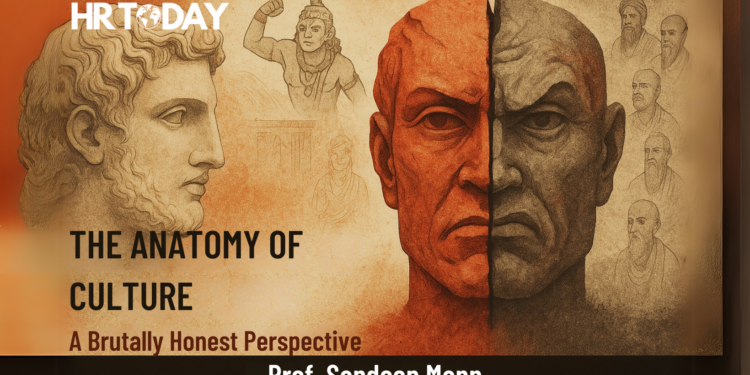The Dilemma of Culture
Culture, often categorized under the ‘soft’ aspects of an organization or society, is paradoxically the hardest to manage. The real challenge with culture is its need for layered interventions—something that cannot be changed by a memo or a workshop. What exacerbates this issue is the lack of brutal honesty from those in leadership, who are expected to set the tone but often falter when it comes to leading by example.
We hear much about the culture of innovation, transparency, merit, ethics, and excellence. Yet, few leaders demonstrate the spine required to uphold these values. The fundamental issue is that culture is not about what is preached but about what is practiced consistently.
“Culture is not about what is preached but about what is practiced consistently.”
The Indian Challenge: Situational Ethics and Policy Paralysis
One of the starkest examples of this cultural dilemma is found in Indian companies, where adherence to fundamental truths is weak. Every situation is handled on a case-by-case basis, with the excuse that “this is how Indian culture operates.” This results in a lack of policy formulation, which in turn prevents effective delegation.
Consider this common scenario: an employee takes four days of unapproved leave. On one occasion, they are excused without question; on another, someone else is reprimanded harshly for being late by two hours. The randomness of disciplinary action creates an environment of uncertainty, favouritism, and inefficiency.
Sales incentives, budgeting, and promotions follow the same erratic pattern. Decisions are made based on opaque heuristics known only to top leaders, making processes non-repeatable and undermining fairness. Employees quickly realize that performance and effort matter far less than networking and sycophancy.
In such an ecosystem, learning and development initiatives become ineffective. True learners and high performers feel demotivated, while mediocrities thrive in a culture of bootlicking. Even a good education does not necessarily equip individuals with the courage to stand for the right, because the system punishes rather than rewards integrity.
“Decisions are made based on opaque heuristics known only to top leaders, making processes non-repeatable and undermining fairness.”

Mythological Anchors: When Culture Became Destiny
History and mythology offer ample evidence of how cultural frameworks shape societies. Take the Mahabharata, where Duryodhana, despite his unethicality and incompetence, thrives in an environment of favouritism. His entitlement is reinforced by a culture where dharma is selectively applied. Contrast this with Yudhishthira, who, despite his moral compass, struggles against a culture that rewards cunning over righteousness.
Similarly, in the Ramayana, Ravana—a learned scholar—fails as a leader because his culture of arrogance and sycophancy blinds him to the voices of reason within his own court. His refusal to heed wise counsel ultimately leads to his downfall. These epics illustrate how cultures that lack consistency, meritocracy, and transparency eventually collapse under their contradictions.
“Cultures that lack consistency, meritocracy, and transparency eventually collapse under their contradictions.”
Philosophical Snippets: The Power of Unspoken Culture
Philosophers like Confucius, Aristotle, and Nietzsche have long debated the role of culture in shaping morality and behaviour. Confucius emphasized the importance of Li (rituals and norms) in creating societal harmony. Aristotle spoke of virtue ethics, where repeated practice of good actions ingrains moral behaviour into culture. Nietzsche, on the other hand, warned against blind adherence to societal norms, cautioning that cultures that do not evolve with time risk stagnation and eventual decay.
A culture that encourages silence in the face of wrongdoing is complicit in its own downfall. As Socrates questioned, “Is it better to suffer injustice or commit injustice?” In organizations and societies where culture is left to chance, individuals often choose self-preservation over truth, perpetuating a cycle of moral decay.
“A culture that encourages silence in the face of wrongdoing is complicit in its own downfall.”
Read Also : HR Is Not a Support Function—It’s the CEO’s Most Powerful Growth Engine
Cultural Frameworks: Change is Possible, But Unlikely
Several theoretical models attempt to address cultural transformation. Edgar Schein’s Organizational Culture Model highlights three levels of culture—artifacts (visible structures and processes), espoused values (stated beliefs), and underlying assumptions (deeply embedded practices). Indian organizations often fail at the third level, as stated values rarely align with real actions.
Kotter’s Eight-Step Change Model, which emphasizes urgency, coalition-building, and embedding change in corporate DNA, is another framework that remains underutilized in India. Without leadership conviction, such models remain aspirational rather than practical.
Caselet 1: The Cost of Favouritism in a Family-Owned Business
Rahul joined his family’s textile business with a vision to modernize operations and introduce transparent performance metrics. However, he soon realized that promotions and rewards were not based on merit but on proximity to the patriarch of the family. His innovative ideas were stifled by senior managers who saw him as a threat. Eventually, demotivated and disillusioned, Rahul left the company, which continued to operate on its old favouritism-based structure, leading to its slow decline in the competitive market.
Caselet 2: The Startup That Thrived on Culture
Contrast this with a technology startup founded by Ananya and Vikram, who believed in a culture of accountability. From day one, they established clear guidelines on performance evaluation, transparent salary structures, and an open-door policy for grievances. Employees felt valued and had clear expectations. As a result, their startup not only scaled rapidly but also retained top talent, setting an industry benchmark for cultural excellence.
Read Also : From Gatekeeping to Gateway Building: Transforming How Organisations Create Access
Objectivity versus Subjectivity
“Western communication has what linguists call a ‘transmitter orientation’–that is, it is considered the responsibility of the speaker to communicate ideas clearly and unambiguously. …within a Western cultural context, which holds that if there is confusion, it is the fault of the speaker. But Korea, like many Asian countries, is receiver oriented. It is up to the listener to make sense of what is being said.” — Malcolm Gladwell, Outliers: The Story of Success
One of the key root cause in professionally managed setups is adherence to objectivity. Social affairs cannot hide, perpetually behind “it depends” – they have to be amenable to scrutiny. Marketing and Finance functions don’t evade numerical evaluation or goal fixing. Human Resources side steps such a mindset, claiming humans are not objectively assessable. Well, sales doesn’t lay a claim or excuse that nobody can predict nature of humans, so sales forecast can’t be done. Why do Human Resources or Strategic Management constantly take such pleas? Surely, contextual elements operate, but there has to be methods to madness. Only then hard minds based culture shall prevail.
“There has to be methods to madness. Only then hard minds-based culture shall prevail.”
Conclusion: What Can Be Done?
To fix culture, leaders need to stop hiding behind situational excuses and enforce consistency in principles. This requires:
- Brutal Honesty at the Top: Leaders must practice what they preach, refusing to bend rules based on convenience.
- Clear and Transparent Policies: Organizations must establish and follow clear guidelines for promotions, rewards, and disciplinary actions.
- Merit over Favouritism: Encouraging a performance-based culture instead of one driven by sycophancy.
- Encouraging Dissent: Cultures that allow questioning and constructive disagreement lead to innovation and integrity.
- Institutionalizing Cultural Values: Leveraging structured frameworks to ensure cultural sustainability.
Without these interventions, culture remains a convenient talking point rather than a transformative force. The challenge is not in defining culture in flowery terms but in having the courage to implement the essence consistently.
As history and mythology teach us, cultures that fail to uphold their foundational truths eventually disintegrate. The question is—will we learn in time?













